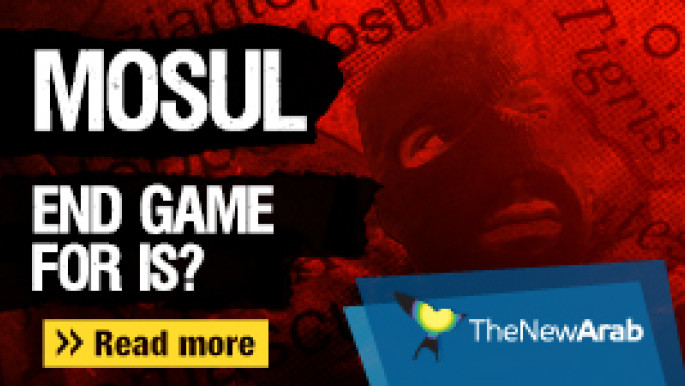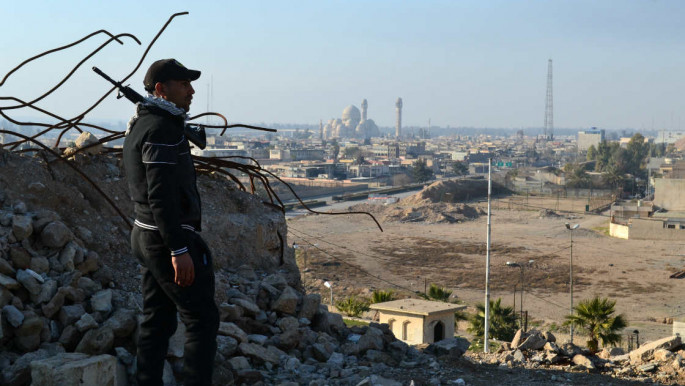Mosul after Islamic State: The rubble of Jonah's tomb
Exclusive: Prayer in a mosque with a tomb is considered 'idol-worship' by the Islamic State group. Gareth Browne reports from the rubble.
4 min read
The shrine had been visited by Iraq's Sunnis, Shia and Christians [Gareth Browne]
The vandalism of the Islamic State group was again laid bare on Monday morning as Iraqi government forces recaptured one of Mosul's most sacred religious sites.
The shrine of Nabih Yunus is the reported burial site of the Prophet Yunus, who appears in the Bible as Jonah.
In the Old Testament, Jonah famously lives inside a whale for three days, and before IS' destruction, the tomb reputedly held one of the whale's teeth.
The destruction came in the summer heat of Ramadan in 2014, barely a month after the militants shocked the world with their rampage across northern Iraq. Rumours circulated for days that the shrine would be destroyed - the group decry prayer at any mosque with a tomb inside as idolatrous.
Around the same time, the mosque imam, Mohammed Abdul Wahab al-Sham, who had found deep respect amonga locals for his sermons of tolerance and championing of the shrine's importance, was threatened with death and forced to flee to nearby Kirkuk.
Early one morning jihadists forced all of the local residents from their homes. At gunpoint they were ordered into the streets and made to watch as the shrine in which generations of their families had prayed five times a day was rigged with explosives.
Barely an hour later the trigger was pulled, and a deafening explosion reduced the shrine to rubble.
But the masked men were not Iraqi, says Mahmoud Ali, who lived just 50 metres from the shrine's main entrance.
"They were French, they didn't speak Arabic. I thought: 'Who is this foreigner destroying my country's history?' I would rather they had destroyed my house than the mosque. It's so painful."
Locals such as Mahmoud were distraught, but powerless to resist.
"They all had guns, we had nothing. If we could have stopped them, we would have."
In the weeks leading up to the shrine's destruction, these same French fighters attempted to pilfer any valuable artefacts form the site, digging deep and loading various statues and engravings onto trucks - destinations unknown.
"They told us it was a site of idol worship, and must be destroyed, but they were happy to make a profit from the idols," Mahmoud told The New Arab.
Atop a small hill, the shrine offers a reaching 360-degree panoramic view of Eastern Mosul. To the north, the Grand Mosque, the city's largest, is visible. To the west lie the ancient ruins of Nineveh.
But even the view was weaponised by the jihadists. As government forces approached, snipers were placed amid the rubble and instructed to fire - not just at advancing soldiers, but at civilians desperately trying to flee the waning caliphate.
Ultimately, with the group collapsing throughout eastern Mosul, their fight here was futile. After a short firefight, the few remaining jihadists fled, and elite counter-terrorism forces declared the site free.
Mahmoud's community of around 500 still live on the hill near the shrine, as they have for generations. In more peaceful days, the shrine, which is mentioned in the Quran, was a site for tourism and pilgrimage.
It offers a glimmer of the coexistence once possible in a now deeply divided country.
"It was not just for the Sunnis; Shia and Christians would come from all over Iraq to pray and to take photos," said Meshwan, another resident.
"This was Iraqi history, it was for everyone."
The shrine of Nabih Yunus is the reported burial site of the Prophet Yunus, who appears in the Bible as Jonah.
In the Old Testament, Jonah famously lives inside a whale for three days, and before IS' destruction, the tomb reputedly held one of the whale's teeth.
The destruction came in the summer heat of Ramadan in 2014, barely a month after the militants shocked the world with their rampage across northern Iraq. Rumours circulated for days that the shrine would be destroyed - the group decry prayer at any mosque with a tomb inside as idolatrous.
Around the same time, the mosque imam, Mohammed Abdul Wahab al-Sham, who had found deep respect amonga locals for his sermons of tolerance and championing of the shrine's importance, was threatened with death and forced to flee to nearby Kirkuk.
Early one morning jihadists forced all of the local residents from their homes. At gunpoint they were ordered into the streets and made to watch as the shrine in which generations of their families had prayed five times a day was rigged with explosives.
Barely an hour later the trigger was pulled, and a deafening explosion reduced the shrine to rubble.
| Article continues below |
 |
| IS fighters looted the shrine's treasured contents, then detonated explosives, turning much of it to rubble [Gareth Browne] |
But the masked men were not Iraqi, says Mahmoud Ali, who lived just 50 metres from the shrine's main entrance.
"They were French, they didn't speak Arabic. I thought: 'Who is this foreigner destroying my country's history?' I would rather they had destroyed my house than the mosque. It's so painful."
Locals such as Mahmoud were distraught, but powerless to resist.
"They all had guns, we had nothing. If we could have stopped them, we would have."
 |
|
In the weeks leading up to the shrine's destruction, these same French fighters attempted to pilfer any valuable artefacts form the site, digging deep and loading various statues and engravings onto trucks - destinations unknown.
"They told us it was a site of idol worship, and must be destroyed, but they were happy to make a profit from the idols," Mahmoud told The New Arab.
Atop a small hill, the shrine offers a reaching 360-degree panoramic view of Eastern Mosul. To the north, the Grand Mosque, the city's largest, is visible. To the west lie the ancient ruins of Nineveh.
But even the view was weaponised by the jihadists. As government forces approached, snipers were placed amid the rubble and instructed to fire - not just at advancing soldiers, but at civilians desperately trying to flee the waning caliphate.
| Article continues below |
 |
| Mosul's Grand Mosque can be clearly seen from the destroyed shrine [Gareth Browne] |
Ultimately, with the group collapsing throughout eastern Mosul, their fight here was futile. After a short firefight, the few remaining jihadists fled, and elite counter-terrorism forces declared the site free.
Mahmoud's community of around 500 still live on the hill near the shrine, as they have for generations. In more peaceful days, the shrine, which is mentioned in the Quran, was a site for tourism and pilgrimage.
It offers a glimmer of the coexistence once possible in a now deeply divided country.
"It was not just for the Sunnis; Shia and Christians would come from all over Iraq to pray and to take photos," said Meshwan, another resident.
"This was Iraqi history, it was for everyone."
With the eastern half of Mosul almost entirely recaptured, a semblance of normality is beginning to return to many parts here; a nearby market bustles, despite the distant rattle of gunfire.
The Nabih Yunus shrine is but one example of the iconoclasm wrought on northern Iraq under IS, but with peace slowly returning to areas once considered the group's heartlands, it remains to be seen what will be done to rebuild the nation's scarred cultural heritage.
Fixing and translation services provided for this report by Makeen Mustafa.
Gareth Browne is reporting from the front lines in the battle to retake Mosul from the Islamic State group. Follow him on Twitter: @BrowneGareth
The Nabih Yunus shrine is but one example of the iconoclasm wrought on northern Iraq under IS, but with peace slowly returning to areas once considered the group's heartlands, it remains to be seen what will be done to rebuild the nation's scarred cultural heritage.
Fixing and translation services provided for this report by Makeen Mustafa.
Gareth Browne is reporting from the front lines in the battle to retake Mosul from the Islamic State group. Follow him on Twitter: @BrowneGareth





 Follow the Middle East's top stories in English at The New Arab on Google News
Follow the Middle East's top stories in English at The New Arab on Google News


